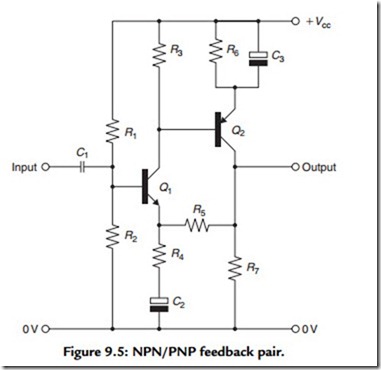Stage Gain
The stage gain of a BJT, used as a simple amplifier, can be determined from the relationship:
where Rs is the source resistance, RL is the collector load resistor, hfe is the small-signal (AC) current gain, and ri is the internal emitter-base resistance of the transistor. An alternative and somewhat simpler approach is similar to that used for a pentode valve gain stage in which
where the gm of a typical modern planar epitaxial silicon transistor will be in the range of 25–40 mS/mA of collector current. Because the gm of the junction transistor is so high, high stage gains can be obtained with a relatively low value of load resistor. For example, a small- signal transistor with a supply voltage of 15 V, a 4 k7 collector load resistor, and a collector current of 2 mA will have a low frequency stage gain, for a relatively low source resistance, of some 300˘. If some way can be found for increasing the load impedance, without also increasing the voltage drop across the load, very high gains indeed can be achieved—up to 2500 with a junction FET acting as a high impedance constant current load.
A predictable, but interesting aspect of stage gain is that the higher the gain, which can be obtained from a circuit module, the lower the distortion in this which will be due to the input device. This is so because if increasingly small segments are taken from any curve, they will progressively approach more closely to a straight line in their form. This allows a very low THD figure, much less than 0.01% at 2 V rms output, over the frequency range 10 Hz–20 kHz, to be obtained from the simple NPN/PNP feedback pair shown in Figure 9.5, which would have an open loop gain of several thousand. The distortion contributed by
Q2 will be relatively low because of the high effective source resistance seen by the Q2 base. A similar low level of distortion is given by the amplifier layout (bipolar transistor with constant current load) described earlier because of the very high stage gain of the amplifying transistor and the consequent utilization of only a very small portion of its Ic/Vb curve.

